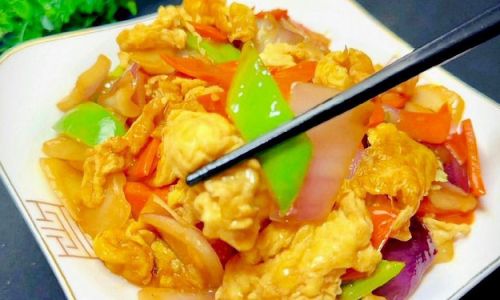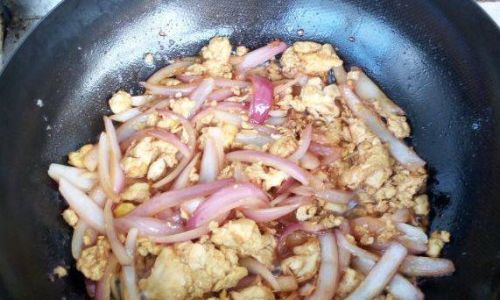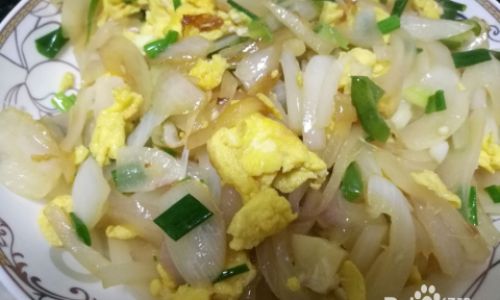Introduction
In the vast culinary landscape, simple dishes often hold the most profound flavors. One such dish that stands out for its simplicity yet rich taste is onion scrambled eggs. This humble combination of ingredients can evoke memories of home-cooked meals, comfort, and nostalgia. But how do you elevate this basic recipe to create a dish that is truly mouthwatering? This article delves into the intricacies of making onion scrambled eggs, exploring techniques, ingredient selection, and flavor enhancements to ensure your dish is not just satisfying but also memorable.

Understanding the Ingredients
Before diving into the cooking process, it’s crucial to understand the role each ingredient plays in the final dish.
Eggs: The cornerstone of scrambled eggs, their quality directly impacts the taste and texture. Fresh eggs have a more vibrant yellow yolk and a firmer white, which holds up better during cooking. Free-range or organic eggs often have a richer flavor profile due to the diet of the chickens.
Onions: There are various types of onions, each with its unique flavor and texture. For scrambled eggs, yellow or white onions are typically used. They add sweetness, a hint of savoriness, and a subtle bite when cooked properly. The key is to cook them until they are translucent and caramelized, which brings out their natural sugars and deepens their flavor.
Salt and Pepper: Basic seasoning, but crucial for enhancing the flavors of the dish. A pinch of salt can draw out moisture in the onions, aiding in caramelization, while freshly ground black pepper adds a layer of complexity.
Butter or Oil: Both can be used, but they contribute different flavors. Butter adds richness and a creamy texture, while oil (such as olive oil or avocado oil) provides a cleaner, lighter taste. The choice often depends on personal preference and dietary restrictions.
Optional Ingredients: For added depth, consider incorporating herbs like chives, parsley, or thyme. A splash of milk or cream can make the eggs creamier, while a pinch of cheese (cheddar, feta, or Parmesan) can add a cheesy tang.
Choosing the Right Pan
The pan you use can make a significant difference in the outcome of your scrambled eggs. A non-stick skillet is ideal because it prevents sticking and makes cleanup easier. However, stainless steel or cast iron pans can also be used if properly seasoned and well-lubricated with oil or butter. The size of the pan is important too; it should be large enough to allow the eggs to spread out evenly, promoting even cooking.
Prepping the Ingredients
-
Eggs: Crack the eggs into a bowl and whisk them thoroughly until the yolks and whites are fully combined. Add a splash of milk or cream if desired, and a pinch of salt and pepper.

-
Onions: Peel and thinly slice the onions. The thinner the slices, the faster they will cook and caramelize.
Cooking Techniques
Now, let’s dive into the cooking process, breaking it down into manageable steps.
Step 1: Preheat the Pan
Place your chosen pan over medium-low heat. Preheating ensures that the pan is evenly heated, which is crucial for even cooking. If using butter, add it to the pan and let it melt, swirling it around to coat the bottom and sides evenly. For oil, pour in just enough to lightly coat the pan.
Step 2: Cook the Onions
Add the sliced onions to the pan. The goal here is to cook them slowly, allowing them to soften, release their juices, and caramelize. This process takes patience; it should be done over medium-low heat to prevent burning. Stir occasionally to ensure even cooking. As the onions cook, they will turn translucent and then develop a golden-brown color, indicating caramelization. This can take anywhere from 5 to 15 minutes, depending on the heat and the thickness of the slices.
Step 3: Season the Onions
Once the onions are caramelized, add a pinch of salt and pepper. This not only seasons the onions but also helps draw out any remaining moisture, further intensifying their flavor.
Step 4: Add the Eggs
Pour the beaten eggs into the pan with the onions. Immediately reduce the heat to low to prevent the eggs from overcooking. Use a spatula to gently stir the eggs, pushing them from the edges toward the center. The goal is to create soft, fluffy curds rather than fully scrambled eggs. Be gentle; over-stirring can lead to rubbery eggs.

Step 5: Cook the Eggs
Continue to cook the eggs, gently stirring occasionally, until they are just set but still slightly runny. The eggs should be creamy and moist, with no visible liquid egg whites. This can take anywhere from 2 to 4 minutes, depending on your preferred doneness.
Step 6: Finish with a Touch of Butter (Optional)
For an extra creamy texture, you can add a small knob of butter to the eggs during the final minute of cooking. The heat will melt the butter, creating a rich, velvety sauce that coats the eggs and onions.
Step 7: Taste and Adjust Seasoning
Before removing the pan from the heat, taste the eggs and onions. Adjust the seasoning with more salt and pepper if needed. Remember, it’s easier to add seasoning than it is to remove it, so start with small amounts and add more gradually.
Serving and Garnishing
Once the eggs are cooked to your liking, remove the pan from the heat. Transfer the onion scrambled eggs to a plate or serving bowl. For an elegant touch, garnish with freshly chopped herbs like chives, parsley, or thyme. A sprinkle of cheese, such as grated Parmesan or a handful of crumbled feta, can also add a delightful finish.
Troubleshooting Common Issues
-
Overcooked Eggs: If your eggs are too dry or rubbery, they have been cooked too long or over too high heat. Reduce the cooking time and lower the heat next time.
-
Undercooked Onions: If the onions are still crunchy, they haven’t cooked long enough. Increase the cooking time and stir less frequently to allow them to caramelize properly.

-
Sticking: If the eggs or onions stick to the pan, ensure your pan is well-lubricated with butter or oil, and that it is preheated properly. Non-stick pans can also help prevent sticking.
-
Greasy Eggs: If your eggs are too greasy, you may have used too much butter or oil. Reduce the amount next time and ensure it’s evenly distributed across the pan.
Storage and Reheating
Leftover onion scrambled eggs can be stored in an airtight container in the refrigerator for up to 2 days. To reheat, place them in a microwave-safe dish and heat on medium power until warm, stirring occasionally to prevent overcooking. Alternatively, you can reheat them on the stovetop over low heat, stirring constantly.
Creative Variations
Once you’ve mastered the basic recipe, feel free to experiment with variations to keep things interesting.
- Vegetable Additions: Incorporate other vegetables like bell peppers, mushrooms, or spinach for added nutrition and flavor.
- Protein Boost: Add cooked bacon, ham, or sausage for a hearty breakfast.
- Cheese Fusion: Mix in different types of cheese for a creamy, cheesy twist.
- Spicy Kick: Add a dash of hot sauce, diced jalapenos, or red pepper flakes for some heat.
- Herbal Infusion: Infuse the eggs with fresh herbs like dill, basil, or rosemary for a unique aroma and flavor.
Conclusion
Onion scrambled eggs may seem like a simple dish, but with the right techniques, ingredient selection, and creative variations, it can become a culinary masterpiece. By understanding the role of each ingredient, mastering the cooking process, and experimenting with different flavors, you can elevate this humble dish to new heights. Whether you’re cooking for yourself, family, or friends, delicious onion scrambled eggs are sure to be a hit. So, the next time you’re in the kitchen, gather your ingredients, preheat your pan, and embark on a culinary journey that celebrates the beauty of simplicity. Bon appétit!






0 comments